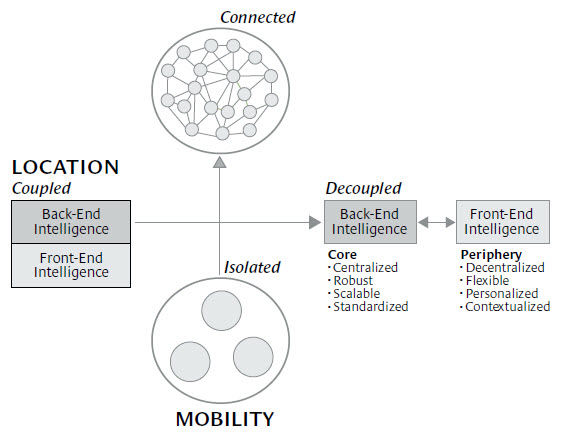Short blog today on an example BNPL opportunity and the differences between a consumer BNPL solution like Apple Pay Later and Merchant integrated solutions from providers such as Affirm (or SQ/Afterpay see Three Flavors of BNPL). Today Air Travel and Vacation packages are the focus.
Tag Archives: value
Walmart – Banking and FinTech
As always pardon the typos
It seems like only yesterday that 30 members of Congress wrote the acting chairman of the FDIC to stop Walmart Bank.
“Wal-Mart’s plan, to have its bank process hundreds of billions in transactions for its own stores, could threaten the stability of the nation’s payments system,”
30 Members of US Congress, March 2006
Of course, we all know that Walmart pursued a different course to deliver services. Partnerships (MGI, Moneygram, Paypal, …) and banking in a box (literally an isle with prepaid cards). Most analysts discount or “write off” Walmart’s achievements in financial services. Given Walmart doesn’t break out financial performance of Money Center, analysts are left with the tea leaves of MGI and GDOT reports. There is little doubt that comparing Money Center financial metrics to tier 1 banks would leave most unimpressed. However, Walmart has created a portfolio of banking services that supports their overall retail strategy and creates overwhelming loyalty amongst their core customer base.
Rewiring – Part 2: Walmart+Goog, Amazon+Whole Foods, …
Google Creating Platform for a New Mobile ECONOMY
Authentication – In “Value” Nets
Consumer Behavior: Discerning and Capturing Value
Nokia, Apple, Android, Value Creation and Distributed Innovation
10 April
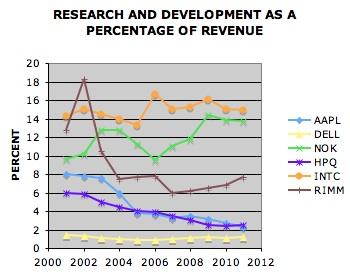 (Cool title…? You can tell I’m an engineer)
(Cool title…? You can tell I’m an engineer)
I was catching up on some reading this Easter weekend and saw one of my old MIT Technology reviews lying around. Article was on Nokia’s new CTO Henry Tirri (Dec 2011). Question came to mind: to what extent does technology influence Nokia’s future success? Is Apple’s current success built on technology? Of course, although any CTO’s job gets harder when their CEO is forming alliances that are 100% potential and 0% market traction…. Oh I forgot Elop also sold your own OS to Accenture so there is “no way back”. (For more background on Nokia/MSFT see this UK Guardian Article).
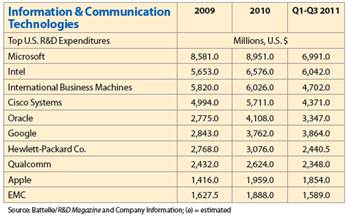 What factors will influence success in Mobile? Obviously it is not R&D, as Nokia’s 2.9B EUR ($3.8B) budget was roughly twice Apple’s $2B (see global 2012 R&D Spending report from Battale). Most would agree that Nokia lost in connecting the phone to the internet.. No amount of internal R&D could have led Nokia to build an equivalent network.. yet they did not fully realize the value that consumers could unlock … at least not much beyond e-mail. (RIM suffered from a similar myopia.. security vs usability locked into the corporate environment). Nokia’s R&D engineers thus toiled away with features they could control and build.. That is what engineers do.. Nokia thought the battle was in feature/function.. and hundreds of specialized designs for many global “segments”. However the consumer opportunity that Apple discovered was not in hardware, but rather in delivering new ways to connect consumers to all things digital… particularly networks (internet, home, social, entertainment, … and eventually office).
What factors will influence success in Mobile? Obviously it is not R&D, as Nokia’s 2.9B EUR ($3.8B) budget was roughly twice Apple’s $2B (see global 2012 R&D Spending report from Battale). Most would agree that Nokia lost in connecting the phone to the internet.. No amount of internal R&D could have led Nokia to build an equivalent network.. yet they did not fully realize the value that consumers could unlock … at least not much beyond e-mail. (RIM suffered from a similar myopia.. security vs usability locked into the corporate environment). Nokia’s R&D engineers thus toiled away with features they could control and build.. That is what engineers do.. Nokia thought the battle was in feature/function.. and hundreds of specialized designs for many global “segments”. However the consumer opportunity that Apple discovered was not in hardware, but rather in delivering new ways to connect consumers to all things digital… particularly networks (internet, home, social, entertainment, … and eventually office).
Will “Apps” be the key to unlocking the value of mobile?
In the press last month, we saw the analysis by Flurry that Amazon is kicking Google’s rear in App store revenue (89%), and that Google itself makes 5x more on IOS than Android. Other recent research from groups like ABI Research reported that mobile app revenue was $8.5B with 39% due to in app purchases (Gartner says $15B). Personally I find both these numbers a little hard to believe, given Google’s Android revenue is $550M and Apple announced back in July that it paid developers $2.5B (cumulatively over life of AppStore). Best guess for Apple’s FY11 Appstore sales is somewhere around $1.6B (see my July Blog)
Total App Store ECOSYSTEM revenue from these Big 3 is therefore approximately
$1.6B + $1.42 (Amazon’s 89% of Apple’s) + $0.55B = $3.57B
Could it be possible that these big 3 contributed less than 50% of global App Revenue? Not likely (sorry Gartner/ABI). As an investor, I’m not keen on Apps as a long lived mobile environment outside of entertainment (subject of another blog). Suffice to say my view is that “apps” are only a temporary technology metaphor for connecting clusters, goods and data. Although not a fan of “apps” I am very grateful that the App environment exists, as it is driving much innovation within a “developer community” (per Platform). Having thousands of brilliant engineers from around the world work to deliver value benefits us all. Which brings me to the topic of distributed innovation.
Open/Distributed Innovation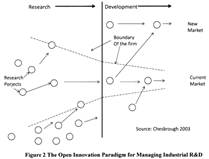
Open Source is a model most of us are well familiar with. (further reading… I ran across a very nicely done paper from 2 MIT students: Implication of Open Innovation and Open source to Mobile Device Manufacturers). Given that mobile, advertising and payments are all networked businesses… it seems business models supporting distributed innovation will advance at a faster pace than those where only a single entity controls the entire product or supply chain. For example, Amazon, Samsung, Motorola, LG, HTC, Verizon, ATT, Vodafone, .. all make much larger investments in the Android platform (than in IOS). (I would love to see an analysis of combined capital investment in android platform)
However, this distributed innovation hypothesis is NOT playing itself out (ie Apple). Apple’s 1Q12 showed iPhone revenue alone was $24.4B, which is bigger than all of MSFT revenue combined. Analysts have shown that Apple now garners 75% of mobile handset profits, with only 9% of handset market share. So while Samsung alone has outsold Apple in Units this quarter (41M vs. 32.6M), and Android just topped 50% market share (vs Apple’s 30.2%).. Apple’s handset business PROFITABILITY dwarfs that of all of the competition (COMBINED).
So… What are the factors of competition today? Can someone else change the game?
Most would agree that Apple has won through a focus on design and customer satisfaction. Nothing looks as good, or works as reliably as an iPhone. It brings a consumer’s digital life together; it is also the channel by which we stay connected when we are not at home. 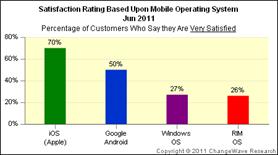 Apple’s unique ability to control design and manufacturing quality has obviously provided many benefits (which customers have proven willing to pay a premium for).
Apple’s unique ability to control design and manufacturing quality has obviously provided many benefits (which customers have proven willing to pay a premium for).
The big downside in distributed innovation is complexity, there is a need for a “channel master” or chaos reigns. Many Android users witness this chaos when an app won’t work on a new hardware/OS combination.. Distributed innovation is not something that established businesses are good at. It has proven most successful in product PLATFORMS where the pace of change in each component is changing at a rate where no one company can make the capital investment to remain competitive (ex. Moore’s Law, PC architecture through present day). Intel played a very important role in this process, as it worked outside the scope of the CPU in areas such as: Intel Architecture Lab (IAL, developed common standards like PCI), stimulated external innovation (developer training, testing, Intel Capital), industry marketing, patent/licensing. Intel defined what the PLATFORM was.. something that is common sense to us today.. but rest assured it was not given to them, rather it was something that they stepped into and took leadership of.
As we look for where the form of mobile competition may change, it would seem to be outside: hardware, software and network bandwith. With respect to hardware, features have recently begun to surpass “good enough” . Samsung’s Galaxy Nexus is an excellent example of how focused hardware innovation has enabled them to surpass the iPhone’s capabilities. If hardware is good enough, and not the primary factor of competition, it must be software, services or data that will drive competition in the next phase…
If platform is decided on software only.. then software platform with most open standard and most users (ANDROID) should dominate as any connected devices (handsets and everything else) have lower cost and more ability to “specialize”, particularly if intelligence is in the network (not the device). But software is currently not the point of competition either… If not DEVICE software.. then what?
Stage 4 – Shift from Integrated Platform to Value Orchestration
Keeping with the assumptions above: hardware becomes “good enough”, platform/software become “ubiquitous”, patents are widely shared (ok this is a joke.. checking if you were sleeping), and the mobile phone transforms into the networked device “bridging” the virtual and physical world then value (and profitability) will shift from platforms executing transactions to entities coordinating interactions. This interaction of entities is what I refer to as Value Orchestration, certainly not a concept I developed. A January 2001 Harvard Business Review Article: Where Value Lives in a Networked World put it this way:
In more general terms, modern high-speed networks push back-end intelligence and front-end intelligence in two different directions, toward opposite ends of the network. Back-end intelligence becomes embedded into a shared infrastructure at the core of the network (cloud), while front-end intelligence fragments into many different forms at the periphery of the network, where the users are. And since value follows intelligence, the two ends of the network become the major sources of potential profits. The middle of the network gets hollowed out; it becomes a dumb conduit, with little potential for value creation. Moreover, as value diverges, so do companies and competition. …. In a connected world, intelligence becomes fluid and modular. Small units of intelligence float freely like molecules in the ether, coalescing into temporary bundles whenever and wherever necessary to solve problems.
This orchestration hypothesis seems to have proven itself in PCs as margin shifted away from the integrated manufacture to component “performance” differentiation (ex. peripheral price/performance) then again to software finally transforming again to orchestrators and “connected” businesses that orchestrate network value (like Amazon, Facebook and Google)…. as hardware evolves into a commodity like business.
The long term investor risk for Apple is that it will not be able to shift to a value orchestration role, and its handset business (while excellent) will no longer garner 75% of industry profits. Where will the high margin businesses develop? If we take a network view, opportunities to create value exist in interaction between clusters (ex. Retailer to consumer, Facebook community to Retailer) and within a cluster (ex Supply chain, healthcare , …etc.). Within this cluster matrix, l like to take a Clayton Christensen view: “what problems are there that the mobile phone can solve”? which each “opportunity” assigned 5 key measures:
1) TAM (Consumers, $ Volume, Growth, …)
2) Disruptive innovation measure – price/performance (ex. Mobile targeted advertising vs. Coupons)
3) Information Control. Who owns it, how is it obtained, accuracy, privacy, (impacts pricing power)
4) Key Alliances and stakeholders
5) Execution risk (ex. Compete with Facebook vs. Building a mobile application for a retailer)
Much of Value orchestration is dependent on data. Consumer data is highly fragmented in the physical world, do consumers/clusters want it consolidated? What are the benefits? Where is it stored (node or cloud)? The HRB quote above painted a picture where “small units of intelligence float freely like molecules in the ether, coalescing into temporary bundles whenever and wherever necessary to solve problems”. Perhaps it is my time as a senior director within Oracle that has ruined my views on data.. but if it floats freely …how on earth can anyone organize it? Doesn’t someone need a directory? for at least one side? How can intelligence be “self assembling” in business?
My firm belief is that we will start a mobile “boom” that will dwarf what we have seen with either the internet, PCs or the industrial revolution. How big? Will at the top of my list for calculating the basis of a “New Mobile” TAM is marketi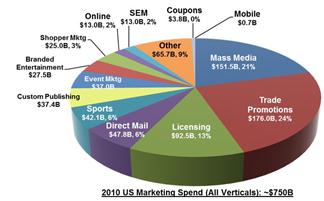 ng.. With the US alone accounting for over $750B .. how much of that spend is targeted?
ng.. With the US alone accounting for over $750B .. how much of that spend is targeted?
Because mobile is at the intersection of both virtual and physical, the network is larger.. it touches every consumer, every business and every “cluster”… it is therefore many orders of magnitude more complex. In this dynamic environment, small companies are much better positioned to deliver “focused”, simple orchestrated solutions between clusters.
Examples of Cluster ochestration:
- Machine-machine interaction (mobile to open hotel room door)
- Person-Person interaction (health history, alergies to Doctor)
- Consumer-Retailer interaction (ex Mobile marketing in brick and mortar retail)
As intelligence develops, it will aggregate (ex Google/Facebook). I covered this topic back my December post Building Networks “The network forms around a function and other entities are attracted to this network (affinity) because of the function of both the central orchestrator and the other participants”. Given that each node and cluster is resource constained.. they maintain connections to a finite number of “efficient” orchestrators/networks. Early networks build very substantial momentum..
Summary
Wow.. this went on too long.. They say a blog over 2 min of reading is a looser.. hey.. you get what you pay for.
Given the mobile device’s unique ability to serve as a point of convergence between the virtual and physical world, a Stage 4 evolution will take place where handsets are cheap and ubiquitous and networks are high speed dumb pipes (both low margin businesses). This Stage may be the leverage point where Apple’s competitors gain differentiation. Perhaps if they had some cash.. and a few bright people they could respond.
There are certainly many scenarios where stage 4 could evolve from. Orchestration requires both back end “cloud” infrastructure and localized intelligence. Both entail a complex interaction of: data, distribution, platform, cluster relationships, business intelligence, control, regulation, trust, … to deliver value. Companies like Google, IBM, Oracle, Facebook… should be able to succeed in the central function. If any of them agree with this blog.. they should actively endeavor to build “interfaces” and standards by which small companies can deliver the localized intelligence.. much the way Facebook has started giving some access to data.
Sorry for size
Comments appreciated.
Customer Centered Design … Why is it SO Hard?
7 Nov 2011
I woke up this AM thinking about consumer value. Why is it that so few existing companies can deliver disruptive consumer value propositions? Execute innovation? It seems as if big companies are more interested in imitating what their competitors are doing … as opposed to focusing on customer (to deliver value). Steve Jobs was one of the few big business CEOs that focused on Customer. He knew that creating a fantastic customer experience was essential in anything to be “sold” to consumers, whether that was Apple or Pixar . Everything flowed from a consumer DESIGN and experience which then evolved to product and subsequently to engineering. Apple was fanatical about customer experience and customer centered design, obviously quality (hardware and software) and connected services were also essential in driving the experience to establish behavior. How many products in the market start with customer centered design? How many of your product heads know their customers and how they differ by segment? My time at Gartner and Oracle led me to a few hypotheses on software products:
- Every Software product usually starts with a customer in mind… but customer focus typically fades fast as other objectives (financial, competitive, alliances, big “special” customers, timeline: execution on “something”…) move the product off of the initial customer centered goal.
- Delivering any consumer value proposition requires either a killer value proposition or a killer distribution channel. Consumer adoption is “unpredictable” at best… be highly skeptical of any initial success (acquiring early adopters of a product) never resembles the broader launch when the product goes mainstream.
- Small companies (leading delivery of a visionary consumer service) require alliance partners… Alliance partners require financial incentives that quickly erode the original value proposition. “when you dance with an 800lb Gorilla, you can expect to have your toes stepped on”. Give equity and it biases your board (focus on their problems/customers), give cash and it kills the consumer or the distribution channel. Equity is better.. but structure in a way you can take them out.
- New Software products within large companies (ie MSFT, SAP, Oracle) are either poorly integrated into the core, or not integrated at all. Product teams can spend over 50% of resources focusing only on internal integration… which further distracts from original customer centered design. There is usually a case for 2 product teams here.. one focused externally on customer and market, they other focused internally on integration requirements.
- Customer testing and trial is a 9 month+ process… no exceptions. Few companies go out of their way to solicit negative customer feedback on a new product. They are much more concerned about “secrecy”… Companies may have justification for short-circuiting (Example: “what are we supposed to do with the engineering team while we wait for feedback”) usually come back to haunt as products in market are much more difficult to change AND effect consumer perception/adoption. Cloud based services are no exception , “lets throw our product out there and see what happens, we will fix bugs later” is not a great business plan. This model makes your early adopters unpaid quality assurance participants..
- Few companies can survive by tackling a niche in the consumer market. There are only 3 markets (US, EU, China) where a 10% market share equates to a sustainable business
- Large companies may not be able to “win” in delivering a new value proposition, but they can muck it up for everyone else. Their game plan is one of “control” over value. They leverage their existing network, infrastructure, products, communication and market power to influence potential customers.
- Consumer visionaries and innovators play a distant second to executives driving financial performance. There are exceptions. For example, Google is also a fantastic innovator, a result of having the best minds working round the clock with pressure to do something great.. not to drive a revenue target.
Story.. my lessons
My lessons learned on customer centered design are many… After Oracle I went back to my old team at Wachovia (which had just bought First Union) our team had launched the world’s first major online bank in 1995 (Cyberbanking).. I was fortunate to return to oversee the complete remaking of our online and payment services infrastructure… a $200M project (2002). As an engineer.. I have many faults.. among them thinking that I know what the customer wants without ever talking to them… We had 2 excellent execs at Wachovia that completely changed the way I thought about customer centered design. We brought customers into the product design process at every stage.. hand drawn screen mock ups.. asking them obvious questions… Why do you do this? what are you looking for? When do you typically do this? What does this mean to you? Jason Ward’s amazing team took this customer feedback and analyzed it to prioritize product design changes. When I started at Wachovia…. we had no facilities or process for including customer feedback, it was the call center’s problem to deal with. After development was complete, we did extended “dog fooding” with employees and customers.. then brought that feedback into refine final release. We also communicated with ALL customers.. why are we upgrading? what will be changing? We explained what things will look like. 3 months before it happened (believe it or not customers don’t like surprises in their bank).
What happened next was something that still amazes me.. During upgrade customer call volume went DOWN.. we transitioned customers from one system to another… completely changed screen flows … and they did not call to ask questions, they did not call to complain.. We had budgeted for extra call center staff.. and we didn’t have anything for them to do.. What was more amazing is that our customer satisfaction went up… DURING the transition to the new system. This is unheard of..
I have now learned that I don’t know what the customer wants or needs.. and the direct customer interaction is VERY beneficial to all involved.. from product to engineering to the call center. Communicating to the customer (if done correctly) is a great thing.. great customers love you and they want to know what you are working on.. find ways to share it with them. If customers perceive they are getting value they want to HELP you. It is imperative to build facilities to get this feedback. In Wachovia there was only 2 regular standing meetings that the CEO would attend… financial and customer listening. Although Wachovia failed on many other grounds.. it taught me the importance of keeping eyes on the customer and ensuring I received the RAW customer data. My priorities became my teams priorities.
Sorry to ramble… I have quite a few peers and former employees read this. Wells Fargo just completed the last migration off of our $200M Wachovia platform. The migration was very well done.. but quite frankly I miss what we had. WFC’s online banking is too clumsy.. too much information.. The difference between using an iPhone and flying the space shuttle (photo below). … although I miss that too.

